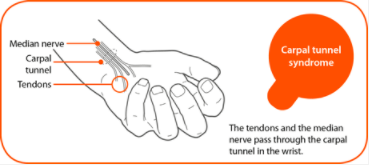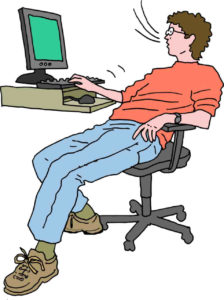
Photo Courtesy: Arthritis Research UK
Did you know that sitting posture and work habits play an important role in exacerbating or preventing Carpal Tunnel Syndrome (CTS)? In a previous article “Does Rolfing® Help Carpal Tunnel Syndrome?” we explored what Carpal Tunnel Syndrome is and how Rolfing can help you recover from this problem. This article will explore the role that sitting posture has on Carpal Tunnel Syndrome and how Rolfing can help you to achieve and maintain good posture.
What does sitting posture have to do with hand and wrist pain?
Sitting posture and pain free hands are intimately connected. Ideally, we sit with our head directly over our shoulders, our shoulders over our hips, our pelvis tipped slightly forward and our feet firmly planted on the ground. This insures that your spine is vertical and that you maintain a slight curve at the waistline and neck. With good alignment, gravity supports your structure. Additionally, both shoulders are relaxed, with a slight bend in the elbows and your forearms are slightly sloped downward. The stage is set. Your wrist and hands are relaxed, fluid & efficient while you type, write and answer the phone. From this posture, you can lean forward to reach, your neck turns effortlessly and breathing is natural and easy. This posture also allows you to shift your weight, and move with freedom.
In summary, good sitting posture:
- Aligns the body in gravity
- Sets the stage for supported, relaxed movement
- Provides the opportunity for weight shifts
- Supports full breath
Gravity poses a challenge for our bodies to maintain upright posture. Poor sitting posture creates the perfect conditions for wrist pain to develop. This is exemplified in the tendency to slump while sitting. When you slump, you loose the supportive curves in your low back and neck. This sets the stage for your head and neck to be in a position forward of your trunk. Poor posture puts you in a relentless struggle against gravity and it becomes difficult to stay upright. Shoulders tend to hunch up, and or slump forward. Again, the stage is set but this time it’s not good; your hands and wrist are elevated as you type on your laptop, or text on your phone.
Picture a chipmunk typing.

Slouching in front of the computer
Poor sitting posture:
- Rounds the low back and neck
- Creates forward head syndrome
- Distorts shoulder position
- Elevates the hands and wrists
- Interferes with weight shifting and movement
- Leads to strain & pain with repetitive movement
Carpal Tunnel Syndrome is one of the many repetitive stress injuries that can occur secondary to long hours of sitting improperly at the computer. Over time, slumping leads to strain, compression and ultimately pain. Wrist pain is reflective of a body that spends too much time in distorted positions.
The contents of this article are not intended to be diagnostic or prescriptive. Always consult a physician before choosing a course of treatment.
